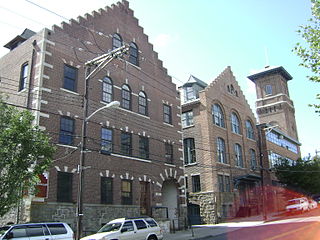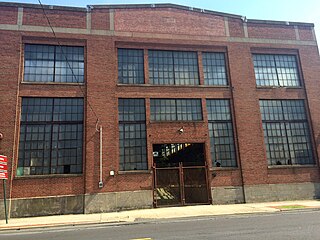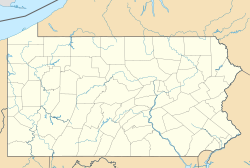
NoHo, for North of Houston Street is a landmarked, primarily residential upper-class neighborhood in the New York City borough of Manhattan. It is bounded by Mercer Street to the west and the Bowery to the east, and from East 9th Street in the north to East Houston Street in the south.

The David McCullough Bridge, commonly and historically known as the 16th Street Bridge, is a steel trussed through arch bridge that spans the Allegheny River in Pittsburgh, Pennsylvania.

The Crescent Brass and Pin Company Building is located at 5766 Trumbull Street in Detroit, Michigan. It was listed on the National Register of Historic Places in 2003. It is currently known as the Research Lofts on Trumbull.

The Graybar Electric Company Building is located at 55 West Canfield Street in Midtown Detroit, Michigan. This warehouse building was rented to the Graybar Electric Company from 1926 into the 1940s. It was listed on the National Register of Historic Places in 1997.

The Knickerbocker Building is an eclectic, Dutch Colonial Revival industrial building located at 50-52 Webster Avenue in the city of New Rochelle, Westchester County, New York.

The Dry Dock Complex consists of six interconnected buildings located at 1801–1803 Atwater Street in Detroit, Michigan, as well as the remains of a nearby dry dock at 1900 Atwater Street. The 1801-1803 Atwater complex is also known as the Globe Trading Company Building. The complex is significant as a historic maritime manufacturing facility. The earliest structure, an 1892 machine shop, is also significant as an early example of an industrial building entirely supported by its steel frame, but using traditional brick and standard windows to infill the curtain walls. The complex was listed on the National Register of Historic Places in 2009. In 2012, the Department of Natural Resources received funding for historic redevelopment of the complex, along the city's east riverfront promenade.

The Bayard School in the Lawrenceville neighborhood of Pittsburgh, Pennsylvania is a building from 1874 and is one of Pittsburgh's oldest surviving school buildings. The school was closed in 1939, along with the nearby Foster School and Lawrence School, when all students were transferred to the new elementary wing of Arsenal Junior High School. It was sold in 1941 and later used as a warehouse. It was listed on the National Register of Historic Places in 1986.

The Linograph Company Building, also known as the Englehart Manufacturing Company Building and RiverWalk Lofts , is a historic building located in downtown Davenport, Iowa, United States. It was listed on the Davenport Register of Historic Properties and on the National Register of Historic Places in 2009.

The Consolidated Ice Company Factory No. 2 was built in 1907 in the Lawrenceville neighborhood of Pittsburgh, Pennsylvania. The site includes a two-story office building and an ice manufacturing plant. The factory was closed in 1951.

The Armstrong Cork Company was a cork manufacturer located at 2349 Railroad Street in the Strip District neighborhood of Pittsburgh, Pennsylvania. The company's building was built circa 1901, and designed by architect Frederick J. Osterling. The building was added to the National Register of Historic Places on May 10, 2005, and to the List of Pittsburgh History and Landmarks Foundation Historic Landmarks in 2007.

The H. J. Heinz Company complex, part of which is currently known as Heinz Lofts, is a historic industrial complex in the Troy Hill neighborhood of Pittsburgh, Pennsylvania. The buildings were built by the H. J. Heinz Company from 1907 through 1958. The complex is listed on the National Register of Historic Places (NRHP) and five of the buildings are listed as a Pittsburgh History and Landmarks Foundation Historic Landmark.

The Wisconsin Wagon Company Factory is a historic factory building located at 602 Railroad Street in Madison, Wisconsin. The Wisconsin Wagon Company built the factory building in 1903 to construct horse-drawn wagons and carriages. The company transitioned the building to an auto factory in 1917 and continued to use it until 1957. The building is a well-preserved example of a textile mill industrial loft, a popular factory style in many industries around the turn of the century. It was added to the National Register of Historic Places in 2002.

The Schmitt and Henry Manufacturing Company is a complex of three historic buildings located in downtown Des Moines, Iowa, United States. The complex was built in three stages from 1901-1914 by Schmitt-Henry, who manufactured furniture. It was designed by Des Moines architect Harry D. Rawson of the firm Proudfoot, Bird and Rawson. Sealy Mattress Company took over the building in 1973 after Schmitt-Henry moved to West Des Moines. Hubbell Reality purchased the complex in 1994 for $75.000. Plans were approved in 2009 to convert the complex, as well as the Hawkeye Transfer Company Warehouse, into loft apartments. It was listed on the National Register of Historic Places in 2010.

The Richter Brewery, also known as the Delta Building, is a commercial building located at 1615 Ludington Street in Escanaba, Michigan. It was listed on the National Register of Historic Places in 2009.

The Pitcairn Building, also known as the Pittsburgh Plate Glass Company Building, is a historic warehouse and light manufacturing loft building located at 1027 Arch Street at the corner of N. 11th Street in the Chinatown neighborhood of Philadelphia, Pennsylvania. It was designed by noted Philadelphia architects G. W. & W. D. Hewitt and built in 1901. It is an eight-story, steel frame building clad in brick and granite with terra cotta details. The building measures approximately 74 feet wide and 172 feet deep. It was originally built as a regional distribution center for the Pittsburgh Plate Glass Company. It later housed a clothing manufacturer, H. Daroff and Sons, who originated the "Botany 500" brand.

The Highland Park Manufacturing Company Mill No. 3 is a historic textile mill complex and national historic district located at 2901 N. Davidson St. in Charlotte, Mecklenburg County, North Carolina. The district encompasses included five contributing buildings and are the original mill building (1903-1904) and major weaving room addition, Gate House, Dye House, Boiler House, and Waste House (1903-1904). The original mill was designed by Stuart W. Cramer and features a four-story tower capped by fancy corbelling and crenelated parapets.

John A. Roebling's Sons Company, Trenton N.J., Block 3 is the northern portion of the former Roebling manufacturing complex in Trenton, New Jersey. The buildings date from 1908–1929 and the site was added to the National Register of Historic Places on August 22, 2012.

H. Lauter Company Complex, also known as J. Solotken Company, Lauter Lofts, and Harding Street Lofts, is a historic factory complex located at Indianapolis, Indiana. It was built between 1894 and 1912, and includes the South Factory, the North Factory, and the Office Building. The factory buildings are in the Italianate and the office building is in the Classical Revival style. The North Factory is a four-story brick building with a raised full basement constructed sometime between 1908 and 1912. The Office Building is a two-story brick building constructed between 1899 and 1908 and has a truncated hipped roof. The four-story, "U"-shaped core of the South Factory was built in two phases; the eastern portion between 1894 and 1898 and the western portion in 1899. The H. Lauter Company furniture manufacturer began in 1894 and they continued to operate at the location until 1936. The buildings have been converted to condominiums and apartments.

The Thomas Driver and Sons Manufacturing Company is a complex of two historic factory buildings in downtown Racine, Wisconsin. The Thomas Driver and Sons manufacturing company itself was a manufacturer of sash windows and doors that was first established in 1867. The buildings, located at 134 South Main Street and 214 State Street, are on opposite sides of Second Street. The site was added to the National Register of Historic Places on July 14, 2004.

























